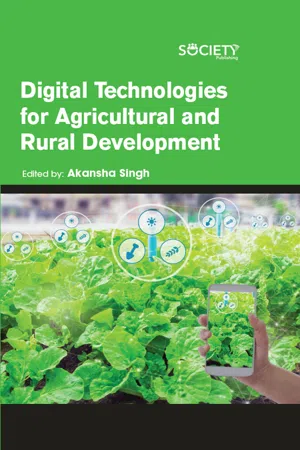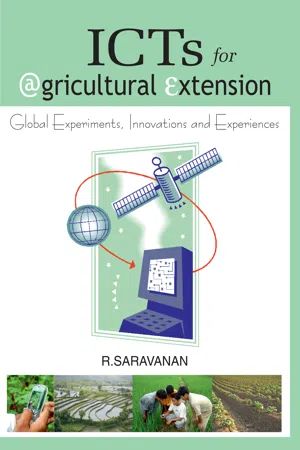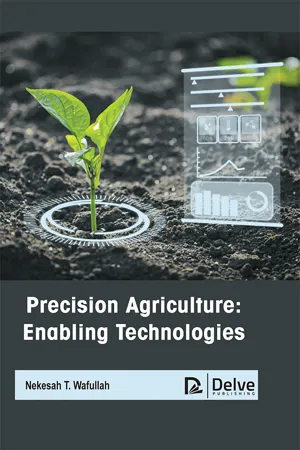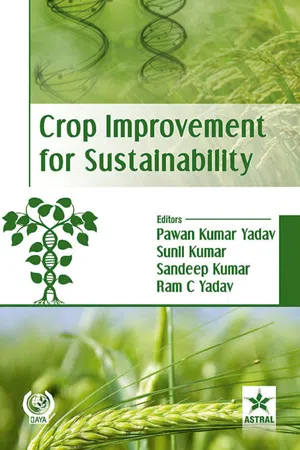Geography
Technology and Agriculture
Technology and agriculture refer to the application of modern tools and techniques in farming practices. This includes the use of machinery, irrigation systems, genetic engineering, and precision farming methods to improve crop yields, reduce labor, and enhance sustainability. The integration of technology in agriculture has led to increased productivity and efficiency in food production, impacting both rural and urban landscapes.
Written by Perlego with AI-assistance
Related key terms
1 of 5
6 Key excerpts on "Technology and Agriculture"
- Akansha Singh(Author)
- 2019(Publication Date)
- Society Publishing(Publisher)
Earlier, the agriculture sector is only linked with the income, employment, and source of food but now the technology has been the key derived for these sources as it has improved the health and well-being that contributes to dynamic, strong, and creative societies. Planning is done for better outcomes along with an exact population level. In the plan making process, the changes will be so powerful, and the outcome should be better with the connecting servicing and land use decisions (Figure 5.3). Figure 5.3: Making space for food. Source: https://www.geograph.org.uk/photo/5266430 Technological Changes in the Agricultural Sector 137 The new rural area will be seen with the increase of new technologies which will bring major shifts in the cities as well as in the societies which have been under process and function. In the 19th century, some areas have moved from primitive city structures to the industrial city model which are driven by new industrial processes. The technology has made the rural agriculture sector simpler and with full of opportunities and avenues. The new agriculture technology is associated with the health sector for addressing the issue. Facilities and services can be provided by analyzing each and every situation of the rural areas and technology help the farmers to earn more money. There has been a large discussion for the rural agriculture planning and it is necessary to know the nature and scope of the development control. Sometimes, the technology will fail to disturb the agriculture value chain because the farmers are not standing in the center of all innovations and people have been failed to provide the inputs. As a result, the economy level will get decrease due to most of the innovations that failed. The team is required for making the farm management effective so they can use the technology for feeding a large number of populations.- eBook - PDF
ICTs For Agricultural Extension
Global Experiments,Innovations And Experiences
- Saravanan, R.(Authors)
- 2021(Publication Date)
- NEW INDIA PUBLISHING AGENCY (NIPA)(Publisher)
People can interact on a web-based platform with subject matter specialists and community members around the globe on topics of your choice. e-agriculture.org encourages the two way exchanges that can empower individuals and communities. This should be a logical step for the Ministry of Agriculture in Trinidad and Tobago. 500 — ICTs for Agricultural Extension — 10. INNOVATIONS FOR THE FUTURE: UNDERSTANDING THE ROLE OFTECHNOLOGY Technology is the systematic study of techniques for making and doing things. Webster’s Dictionary defines technology as «the totality of means employed to provide objects necessary for human sustenance and comfort». Technology is also basic to the survival of culture, and introducing technologies into institutional practice must be based on behavioral knowledge of change (Bennis et al. , 1969). Technology therefore embraces a growing range of means, processes, and ideas in addition to tools and machines. It involves knowing the cause and effect relationships embedded in machines and methods (Sproull and Goodman, 1990). Technology can be disruptive or sustaining. Disruptive technologies are innovative that may not fit with traditional standard practices. Initially they may be viewed with scepticism since the initial benefits are not apparent. Extension by nature prefers sustaining technologies because they maintain the status quo (Coates, 2004). But ICT can be disruptive, and is changing organizational structures in the workplace. Knowing how to implement ICT in Trinidad and Tobago can bring extension gracefully into the next century; but present organizational structures must be adjusted to take advantage of this technology (Margaret, 1989). Case studies show that social alliances can effect rapid improvements in local institutions confirming that bureaucratic reform and improved community social organizations allow for powerful coalitions and rapid, self-sustaining development (Monica et al. , 2000). - eBook - PDF
- Nekesah T. Wafullah(Author)
- 2023(Publication Date)
- Delve Publishing(Publisher)
Use of GIS in Agriculture A Geographic Information System (GIS) is a technology that helps people make better decisions by creating visual representations of data and doing geographical analyses. It’s a technology that mixes hardware, software, and data in one package. As long as the data has a geographic component, it can represent practically anything. Anything from a desktop computer or laptop to satellites, drones, and handheld GPS units can be used as hardware. There are other software packages available, but the ArcGIS suite from ESRI is the industry standard. GIS is used in the public, private, and non-profit sectors to manage public utilities and organize the transportation and distribution of commodities and services. In traditional map construction, GIS is highly useful for plotting things like fire hydrants along a road or drawing borders, such as the area of different crop fields on a farm. However, GIS’ true strength resides in its capacity to evaluate numerous data layers or variables. Technologies in Precision Agriculture 43 A map indicating the number of farm injuries by county, or the number of crop acres lost to flood by tax map parcel, are simple examples of this in agriculture. The changing color ramp is the most typical approach for the polygons representing different ownership or municipality to convey the change in values. In agriculture, more advanced spatial analyses may evaluate variables such as soil type, wind direction, rainfall amount, slope, aspect, terrain, or elevation to aid in crop management, site suitability, and drainage planning, as well as risk prevention from flood, drought, erosion, and disease. GIS can assist a farmer in adapting to these various circumstances, monitoring the health of particular crops, estimating yields from a specific field, and maximizing crop production. GIS data is available for free and for a fee from a variety of sources. - eBook - PDF
Visualizing Human Geography
At Home in a Diverse World
- Alyson L. Greiner(Author)
- 2017(Publication Date)
- Wiley(Publisher)
(Source: Adapted from Chisholm, 1968.) Livestock ranching Grain farming Forestry Market gardening Central city Navigable river Mixed crop and livestock farming Model with a uniform surface Model altered by navigable river A small city with its own production zones Livestock fattening 1. What accounts for our ability to profitably transport timber over longer distances today? 2. What does the diagram suggest about how terrain might influence land use? 3. What type of space—absolute, relative, or relational—informs this model? Think Critically 256 CHAPTER 9 Agricultural Geographies 3. Explain how agriculture has been affected by globalization. 4. Identify at least two global food issues. 1. Define desertification and salinization. 2. Distinguish between sustainable agriculture and organic agriculture. Agriculture, the Environment, and Globalization LEARNING OBJECTIVES A griculture and the environment are inti- mately interconnected. Soil or climatic con- ditions in an area can influence decisions about what to grow or how to use the land. At the same time, the practice of agriculture can have a significant impact on the environment. Since the first agricultural revolution, clearing forests and draining wetlands have been common strategies for in- creasing the acreage devoted to cropland. Human actions as well as changes in climate can contribute to desertification. Overgrazing damages veg- etation, while poor crop management depletes the soil’s fertility. Both of these practices can create environments that are unable to sustain the herds or crops that they once did. Irrigation can have a detri- mental effect on the environ- ment, even though it is usually thought of as a strategy for ex- panding agriculture. If irrigation draws on groundwater aquifers, water usage has to be monitored so that the aquifer is not depleted. In soils that drain poorly, irrigation can lead to waterlogging and crop death. - eBook - PDF
- Yadav, Pawan Kumar(Authors)
- 2018(Publication Date)
- Daya Publishing House(Publisher)
29: Role of Information Technology in Agriculture KS Nehra 1* , Mukesh R Jangra 1 , Sumit Jangra 2 and Raj Kumar 3 1 Dept. of Biotechnology, Govt College, Hisar- 125 001, India 2 Dept. of Molecular Biology, Biotechnology & Bioinformatics, CCSHAU, Hisar- 125 001, India 3 Dept. of Botany, Govt College, Hisar- 125 001, India *Corresponding author: [email protected] Abstract Information technology can be defned as a set of various technical tools and resources used to communicate, broadcast, deposit and handle information. Information technology include computers, internet, networking hardware and software, satellites, broadcasting technologies (radio and television), and telephony (land lines and cellular). In addition to this, it requires services and functions linked with it for instance web portals, email, SMS, video-conferencing, etc. In short information technology is helpful to communicate the knowledge. In developing countries like India where Agriculture is a major contributor to GDP, it cannot be ignored in an era of rapid transformation. Information technology refers to how we use information, compute and communicate information to the people The role of information technology is, users need with the right information, in right form, in right time. The generation and application of agricultural knowledge is progressively important, particularly for small and marginal farmers, who require relevant information in order to improve, sustain, and diversify their farm This ebook is exclusively for this university only. Cannot be resold/distributed. enterprises. Keywords: Agriculture, farming, information technology, rural, population and internet. Introduction The potentiality of agriculture in economic growth of a nation was recognized long back in 2009 by Byerlee and Sadoulet. Despite tremendous eforts, the agricultural production and productivity in the developing countries has declined in the last few decades. - Karen, S T(Authors)
- 2018(Publication Date)
- Agri Horti Press(Publisher)
Conceptualization of technological change in agriculture Technological change is among a small handful of topics in what is now referred to as the sociology of agriculture — along with part-time farming and analysis of the farm family — that have received attention during all three major phases in rural sociology. From the 1930s through the 1950s there were several major studies by sociologists of the impacts of technological change, most of which centred on the rapid mechanization of southern agriculture that began during the Great Depression. The concern of many of the early rural sociologists with the socioeconomic This ebook is exclusively for this university only. Cannot be resold/distributed. 2 Biotechnology for Food, Environment and Agriculture consequences of technological change, however, largely lapsed during the succeeding phase of rural sociology in which the diffusion-adoption perspective was dominant. In the era of the “new sociology of agriculture,” we again see a rekindling of concern with the social consequences of technological change. Moreover, interest in the consequences of technological change has become expressed in more social structural terms and, as demonstrated later, has become more closely integrated with analyses of the genesis of new agricultural technologies. Several other important observations can be made on the rural sociological literature on technological change in agriculture over the past decade. First, mechanization has received the lion’s share of attention; technological change in the forms of improved varieties of crops and breeds of livestock or of agricultural chemicals has been the focus of only a few major ex post studies.
Index pages curate the most relevant extracts from our library of academic textbooks. They’ve been created using an in-house natural language model (NLM), each adding context and meaning to key research topics.





